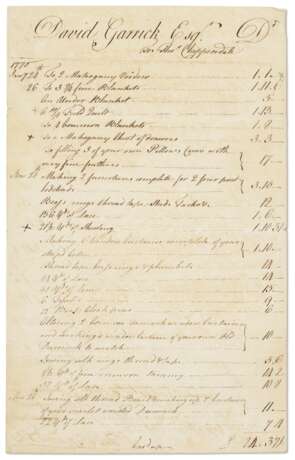ID 627649
Lot 160 | A previously unknown invoice for furnishings
Valeur estimée
$ 4 000 – 6 000
Two pages, bifolium, 321 x 203mm (mild toning to first page, a few pinholes along spine). Endorsed on the docket in the hand of David GARRICK (1717-1779).
Thomas Chippendale invoices David Garrick for furnishings--a fresh addition to the documentary record of the furniture maker's most important patrons. Chippendale bills for work undertaken between 24 January to 18 July 1770, totaling £56-12-11. The bill includes several pieces of furniture including, on 26 January: "a Mahogany Chest of drawers" (£3-3), and on 20 March he billed for "Making 2 furnitures complete for 2 four post bedsteads" (£3-10). On 29 March, Chippendale billed for several pieces including "A Mahogany bureau dressing Chest 2nd hand" (£3), "A Mahogany dumb waiter" (£1-9),"A Mahogany Pillar & Claw table with an Oval top" (£1-11), A Mahogany Sofa stuff[e]d in best linen with 2 feather bolsters & strong Castors on the feet" (£5-5), "2 Mahogany bookshelves for 2 Windows" (£2-6), as well as "filling your frames to the bottoms with Canvas in A Bed Waggon with box & heater complete" (£1), while on the 30th he charged £10-10 for "3 Large Mahogany dining tables with Compass Ends and made to join together." In May, Chippendale, produced a pair of more intimate pieces namely "A large Mahogany night table & necessary Stool of fine wood with a Stone pan" (£2-12-6). In addition to wood furnishings, Chippendale supplied soft goods including blankets, quilts, lace (106 yard of it on 20 March), tassels, "Crimson Check" for cushions, and "Striped Cotton cases to 2 large easy Chairs" (£1-12). Additionally, Chippendale's shop undertook alternations and repairs as well as sewing curtains and stuffing cushions. Chippendale accepted a partial payment of £32 which included a 10 shilling allowance "on two book shelfs," and then on 27 June, he acknowledged receipt of an additional £24-12-11 which settled the account as well as a "further sum of fifteen pounds Eight Shilling and Eight pence on Account" — presumably for future work.
The famous 18th-century actor and playwright David Garrick was one of Thomas Chippendale’s greatest patrons and clients, and as a prominent public figure his enormous commissions provided Chippendale with expansive public exposure beyond his aristocratic subscribers. Garrick commissioned furniture from Chippendale from at least 1768 until his death in 1779, as documented in several sources, most notably a series of accounts now at the National Art Library in the Victoria and Albert Museum. Following on from the success of his first decade in business directly with public patrons, catalyzed by three editions of the Director and new larger premises on St Martin’s Lane, Chippendale was by 1768 already under way with two of his most celebrated and extensive commissions for Harewood House and Nostell Priory, which were similarly in collaboration with the greatest neoclassical architect Robert Adam. Indeed it was Adam’s confidence in Chippendale’s abilities to execute furnishings and collaborate with him on these vast new houses which resulted in continuing success, ensuring that by 1770 Chippendale was at the very apex of his career.
Yet that accounting record, totaling over £900 for work at both Garrick's homes in London (first on Southampton Street and later at No. 5 Royal Adelphi Terrace) as well as his country estate at Hampton, has a significant gap from July 1769 to January 1771 — specifically the crucial moment when Garrick was preparing to move to his new and vastly grander house on Robert Adam’s Adelphi. Christopher Gilbert speculated "that a lost bill bridges" that void in the documentary record (The Life and Work of Thomas Chippendale, 236-245). While this may not be the lost bill, it is most certainly one of the lost bills that further pieces together this important documentary record. Adelphi was at the time the largest neoclassical building in London- designed by Adam and furnished by Chippendale, the greatest architect and cabinetmaker of the 1770s, it was one the most extravagant London houses to have been created at the time. This bill documents furniture created for the lesser rooms at Adelphi or for his house at Hampton or Southampton Street, as it is plainer in its item descriptions than the known furniture made for the Adelphi, which was painted or gilt. In addition to new furniture commissions, Chippendale also supervised thirty cartloads of furniture taken from Garrick’s house at Hampton to his workshops for cleaning, re-upholstering and renovation in preparation for Adelphi, and we can see in this bill examples of this being undertaken.
| Artiste: | William Shakespeare (1564 - 1616) |
|---|---|
| Technique appliquée: | Crayon |
| Artiste: | William Shakespeare (1564 - 1616) |
|---|---|
| Technique appliquée: | Crayon |
| Adresse de l'enchère |
CHRISTIE'S 8 King Street, St. James's SW1Y 6QT London Royaume-Uni | |
|---|---|---|
| Aperçu |
| |
| Téléphone | +44 (0)20 7839 9060 | |
| Commission | see on Website | |
| Conditions d'utilisation | Conditions d'utilisation |












